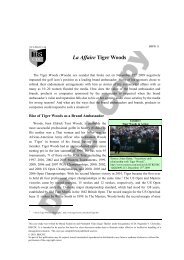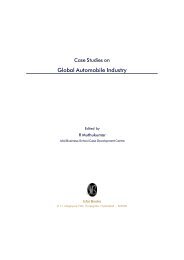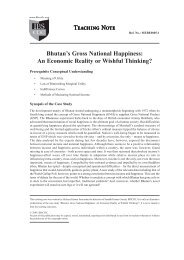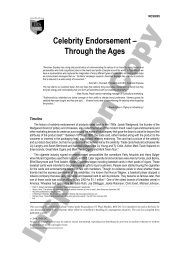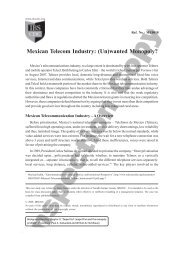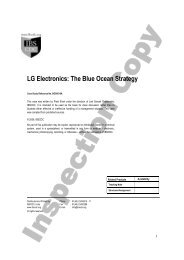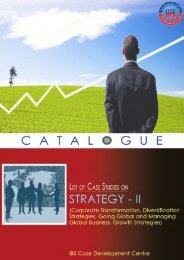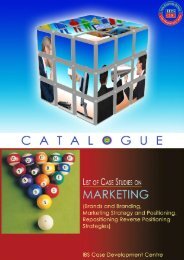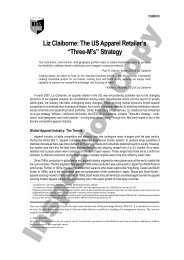Entrepreneurship Case Studies Catalogue
Entrepreneurship Case Studies Catalogue
Entrepreneurship Case Studies Catalogue
You also want an ePaper? Increase the reach of your titles
YUMPU automatically turns print PDFs into web optimized ePapers that Google loves.
transform his company from an upstart<br />
into a media and financial-data giant<br />
• To discuss whether the departure of<br />
Michael Bloomberg who played an<br />
instrumental role in the company’s<br />
growth, would hamper its prospects.<br />
Industry Information Collection and<br />
Delivery<br />
Reference No. ENT0017<br />
Year of Pub. 2004<br />
Teaching Note Not Available<br />
Struc.Assig. Not Available<br />
keywords<br />
Bloomberg; Michael Bloomberg; Salomon<br />
Brothers; Merrill Lynch; Reuters;<br />
Terminals; Bloomberg Professional service;<br />
Bloomberg news; Bloomberg business radio;<br />
Bloomberg television; Bloomberg<br />
magazine; Thomson Financial; New York<br />
City Mayor; Matthew Winkler; Jonathan<br />
Fram.<br />
Aravind Eye Hospitals: A <strong>Case</strong> in<br />
Social <strong>Entrepreneurship</strong><br />
Aravind eye hospitals, (a $11 million<br />
venture) based in Madurai, India, is one of<br />
the largest eye hospitals in the world, and<br />
in terms of scale, the single largest provider<br />
of eye surgeries. Started as an 11-bed<br />
hospital by Dr. G. Venkataswamy, the<br />
Aravind conglomerate now consists of<br />
hospitals, an intraocular lens manufacturing<br />
unit and community development and<br />
research institutes. Though two-thirds of<br />
the surgeries are performed free of charge,<br />
Aravind is financially self-sufficient. A high<br />
level of efficiency in all its activities is<br />
seen as one of the secrets behind Aravind's<br />
success.<br />
Pedagogical Objectives<br />
• To discuss how firms, especially in<br />
developing countries, with a low capital<br />
base can sustain themselves through<br />
streamlined operations and a focused<br />
approach towards growth<br />
• To discuss ‘Aravind as a role model for<br />
businesses’ that serve the ‘bottom of the<br />
pyramid’, as pointed by Professor C K<br />
Prahalad.<br />
Industry Health Care<br />
Reference No. ENT0016<br />
Year of Pub. 2004<br />
Teaching Note Available<br />
Struc.Assig. Not Available<br />
keywords<br />
Aravind eye hospitals; Dr Govindappa<br />
Venkataswamy; Efficient in operations;<br />
Curable blindness; Cataract; Bottom of the<br />
pyramid; Developing countries; Intraocular<br />
lens; Aurolab; Community development;<br />
Eye camps.<br />
Philip Green: UK’s Retail Baron<br />
Philip Green (Green) became the fastest<br />
billionaire in the corporate history of the<br />
UK and earned the reputation as one of<br />
the most successful businessmen in the<br />
country. Nicknamed as ‘canon the<br />
barbarian’ for his ruthless negotiation skills,<br />
Green made his fortune by transforming<br />
the fortunes of two ailing clothing chains<br />
– British Home Stores and Arcadia Group.<br />
In a short career of 20 years, Green built<br />
Britain's largest privately-owned retail<br />
group and accumulated adequate debt free<br />
assets that put him among the top business<br />
leaders in the UK.<br />
Pedagogical Objectives<br />
• To discuss the management style of<br />
Philip Green and how he managed to<br />
turnaround the fortunes of the retail<br />
companies he acquired<br />
• To discuss the role of private ownership<br />
in Green's turnaround efforts.<br />
Industry Retailing<br />
Reference No. ENT0015<br />
Year of Pub. 2004<br />
Teaching Note Not Available<br />
Struc.Assig. Not Available<br />
keywords<br />
Philip Green; Retailing; British Home<br />
Stores and Bhs; Arcadia; Marks & Spencer;<br />
Private ownership versus public ownership;<br />
Storehouse Group; UK clothing industry.<br />
Thor Industries: <strong>Entrepreneurship</strong><br />
Initiatives at Recreational<br />
Vehicle Leader<br />
Thor Industries, the world’s biggest<br />
recreational vehicle manufacturer, has<br />
become the market leader by acquiring<br />
companies, allowing them to operate<br />
independently and giving them autonomy<br />
to compete with each other. The managers<br />
of the acquired companies operate like<br />
entrepreneurs and are rewarded with a<br />
percentage of the division’s pre-tax profits<br />
with no higher limit set as to what they<br />
can be paid.<br />
Pedagogical Objective<br />
• To discuss how the company managed<br />
the constituent units, offering them<br />
autonomy, encouraging competition and<br />
how it became a market leader.<br />
Industry Recreational Vehicle Industry<br />
Reference No. ENT0014<br />
Year of Pub. 2004<br />
Teaching Note Not Available<br />
Struc.Assig. Not Available<br />
keywords<br />
Intrapreneurship; Recreational vehicle<br />
industry; Towable recreational vehicles;<br />
Managerial autonomy; Thor Industries;<br />
Compensation system.<br />
Social <strong>Entrepreneurship</strong>: Serving<br />
the ‘Niche’ Business<br />
Earning by serving the neglected sections<br />
of the society is the bottom line of Social<br />
<strong>Entrepreneurship</strong>. Unlike traditional<br />
philanthropists and social workers, who<br />
address social problems and endeavour to<br />
uplift the conditions of the downtrodden<br />
of the society, social entrepreneurs try to<br />
address social problems at their roots.<br />
Instead of giving a hand holding to the<br />
victims of various social systems, they<br />
strive to change the system itself.<br />
Pedagogical Objective<br />
• To understand the evolution of Social<br />
<strong>Entrepreneurship</strong>, its operating model<br />
and how it is going to change the face of<br />
social philanthropy.<br />
Industry Not Applicable<br />
Reference No. ENT0013<br />
Year of Pub. 2004<br />
Teaching Note Available<br />
Struc.Assig. Available<br />
keywords<br />
NGOs (Non Government Organisations);<br />
Venture philanthropy; Double bottom-line;<br />
Social entrepreneurs; Ashoka Fellows; Skoll<br />
Foundation; Shri Mahila Griha Udyog<br />
Lijjat Papad; Mohammed Yunus and<br />
Bangladesh Grameen Bank; Martin Fischer<br />
and ApproTech; Iqbal Qadir and<br />
GrameenPhone in Bangladesh; Ben &<br />
Jerry's Ice Cream; Social entrepreneurship;<br />
Jeff Skoll; Bill Drayton.<br />
Li Ka-Shing: The New ‘Old’<br />
Entrepreneur<br />
Li Ka-Shing, the Hong Kong business<br />
tycoon is the richest Asian in 2004 and<br />
owns two of the major Hong Kong business<br />
houses (hongs), Hutchison Whampoa and<br />
Cheung Kong (Holdings). His conservative<br />
accounting, sense of timing and ability to<br />
recruit talented people, are considered to<br />
be the assets that made him the 19 th<br />
richest man in world in the Forbes 2004<br />
list with a net worth of $12.4 billion. His<br />
political connections, large size of his<br />
business and his philanthropy were<br />
considered as the basis for his success.<br />
Pedagogical Objectives<br />
• To discuss the entrepreneur’s life and<br />
his deal making abilities and how his<br />
quick decision making helps him make<br />
good deals and quickly move away from<br />
non-lucrative ones<br />
• To discuss Li Ka-Shing's achievements<br />
and his attitudes and beliefs that moulded<br />
www.ibscdc.org<br />
ENTREPRENEURSHIP<br />
ENTREPRENEURSHIP<br />
7



